Whether you're a seasoned outdoor climber or a rock gym enthusiast eager to lead your first outdoor climb, the right climbing gear can make all the difference on your vertical path.
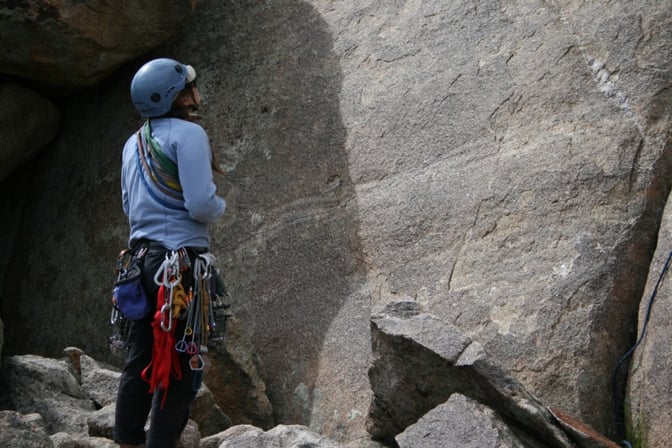 Photo by Lindsay Nohl
Photo by Lindsay Nohl
Your equipment choices play a pivotal role in not only enhancing your overall climbing experience but also ensuring that you are as secure and protected as possible during your climb.
From harnesses that serve as your lifeline to climbing shoes offering precision and grip, we delve into the essentials. We'll also discuss the importance of belay devices, carabiners, helmets, climbing ropes, and protection devices, all vital components in your climbing arsenal.
The Essentials of Rock Climbing Gear
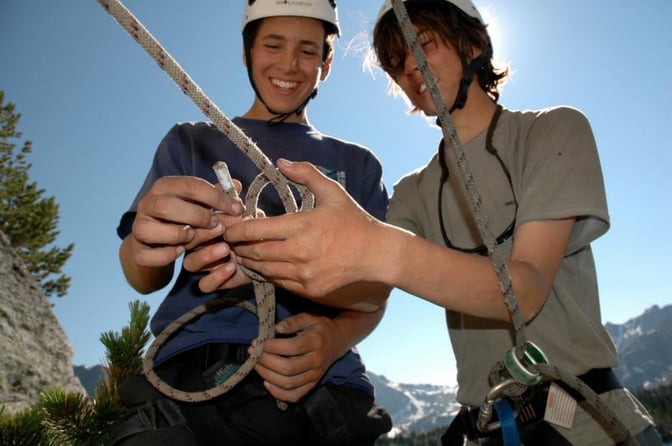 Photo by Becca Parkinson
Photo by Becca Parkinson
Beyond the thrill of reaching new heights and sending challenging routes, rock climbing demands meticulous attention to detail, particularly when it comes to equipment. Understanding the essential pieces of rock climbing gear, their purposes, how to use them properly, and why selecting the right equipment for you and the type of climb is vital to mitigating risks and allowing for a fun climbing experience.
As a note, we recommend always using climbing gear that is UIAA-certified. UIAA certification is the most important aspect of any weight-bearing climbing equipment.
Harness: Your Connection to the Vertical World
Your climbing harness is more than just a snug-fitting belt; it's your lifeline as a climber. Harnesses come in various designs, but their primary function is to secure you to the rope, ensure you will be protected in a fall, and allow you to move confidently on the rock. It's essential to choose a harness that fits comfortably, distributes your body weight evenly, and includes gear loops for holding essential items like carabiners, slings, and quickdraws.
Climbing Shoes: Precision and Grip
Climbing shoes are like the tires of a rock climber's vehicle. They provide the necessary grip and precision required to navigate even the smallest footholds and rock edges. Selecting shoes that fit snugly but not uncomfortably tight is important for both performance and comfort. It's worth noting that trying on shoes in person, preferably with expert guidance, is highly encouraged.
Keep in mind that leather shoes typically stretch by half to a full size, while lined or synthetic shoes may stretch from none to half a size. Generally, climbers opt for shoes that are half to a full size smaller than their street shoes, recognizing that shoe fit can vary among manufacturers.
Belay Device: Controlling the Rope
A belay device is a critical piece of gear that enables you to control the rope's tension, allowing for proper belaying and rappelling. Understanding how to use this device properly is vital for both risk management and leadership development when it comes to partner climbing. Learning various belay techniques and rope management skills from a seasoned climber helps to ensure a secure and enjoyable climbing experience.
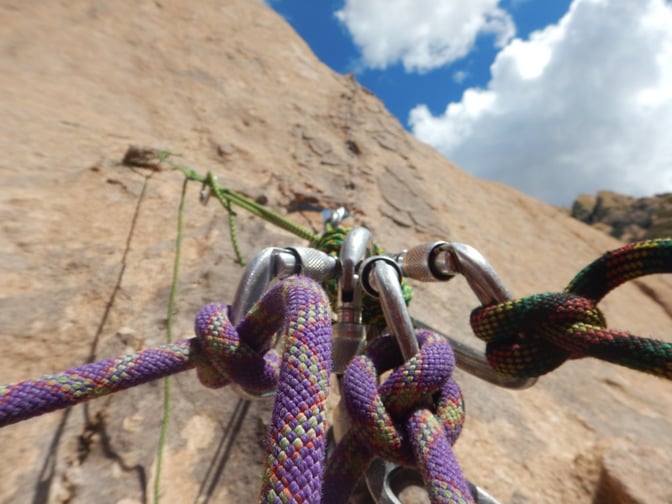 Photo by Matthew Schilowitz
Photo by Matthew Schilowitz
Carabiners and Quickdraws: The Connection Points
Carabiners and quickdraws are the essential connectors in your climbing setup. They allow you to attach your rope to protection points (such as cams, nuts, and bolts) on the rock.
Understanding the proper techniques for clipping and unclipping, preventing cross-loading, and regularly assessing the condition of your climbing gear are central to enhancing safety and minimizing the inherent risks associated with rock climbing.
When it comes to clipping and unclipping, the proper techniques involve precise movements and attention to detail. When attaching or removing a carabiner, it's essential to ensure that the gate is correctly oriented, allowing for smooth and secure connections. Mistakes in these actions can lead to dangerous situations, compromising the integrity of your protection and increasing the chances of accidents.
Preventing cross-loading is another vital aspect of climbing. Cross-loading occurs when a carabiner is under lateral (sideways) force, rather than the intended axial (vertical) load. This can weaken the carabiner and result in catastrophic failures. Climbers should be well-versed in techniques to minimize the risk of cross-loading, such as using locking carabiners, understanding the appropriate orientation, and using proper gate positions.
Helmets: Protecting Your Most Valuable Asset
In the climbing community, wearing a helmet is not always as common as it should be. For those who are primarily accustomed to indoor climbing, it's common to see climbers ascend without head protection. Choosing not to wear a helmet in a climbing gym is relatively less dangerous than doing so in an outdoor setting because gyms offer a more controlled environment.
However, once climbers venture into the great outdoors, the dynamics — and the need for head protection — change dramatically. The controlled gym setting is replaced by rugged rock faces, where the risk of falling rock debris and accidental head bumps against the unyielding stone becomes very real. It's in this outdoor realm that a helmet becomes the paramount defense against potential head injuries.
Climbing Ropes: The Backbone of Climbing
Your climbing rope is the backbone of your entire climbing system. Dynamic ropes provide the essential elasticity required to absorb the energy of a fall, reducing the force exerted on your body and gear. Taking the time to learn about the importance of proper rope care and inspection, how to tie the fundamental rock climbing knots, as well as the proper techniques for belaying and rappelling is vital for safety and partner well-being in climbing.
Protection Devices: Nuts, Cams, and More
Protection devices, including nuts and cams, are essential for creating anchor points on the rock and protecting against falls. Understanding how to place and assess the reliability of these pieces of equipment is crucial for risk management.
Whether you're climbing with an instructor or on your own, mastering gear placement empowers you to protect yourself and your climbing partners effectively.
Rock Climbing Gear for Different Climbing Styles
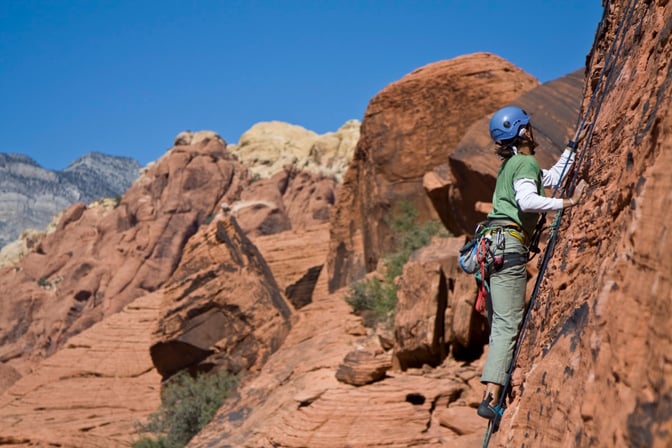 Photo by Rainbow Weinstock
Photo by Rainbow Weinstock
Now that you've got an idea of the basic rock climbing gear, it's time to delve into how your equipment selection can vary based on the different rock climbing styles. We'll explore the gear specific to bouldering, sport climbing, and traditional (trad) climbing.
Understanding the nuances of these gear choices will not only enhance your security on the rock face but also optimize your climbing performance and overall enjoyment. Whether you're a novice or an experienced climber, tailoring your gear to the type of climbing and the environment you'll be tackling is essential.
Keep in mind that hands-on instruction from seasoned climbers is invaluable for gaining the knowledge and skills necessary to make informed gear choices.
Bouldering Gear
Bouldering is a form of rock climbing that involves shorter, yet often incredibly challenging, routes typically no higher than 20 feet. Since boulderers don't use ropes for protection against falls, their gear is notably different. Whether you're bouldering in an indoor rock gym or out in the wilderness, you'll likely make use of the following equipment:
- Crash Pads: These large, cushioned pads are your best friends in bouldering. They provide a softer landing zone and reduce the impact on your body in case of falls.
- Chalk Bag: A chalk bag, fastened around your waist, can come in handy. Maintaining a good grip is crucial in bouldering, and chalk helps keep your hands dry.
- Climbing Shoes: As with other forms of climbing, climbing shoes are essential for precision and grip, even in bouldering. Due to the challenging nature of bouldering, boulders often fit their climbing shoes tighter with a more aggressive down turn to them. If you are new to climbing, we still recommend you start with a snug, but neutral (non-aggressive) climbing shoe as it is really easy to size shoes too small in the beginning.
- Spotter: Outdoor bouldering does have risks, and going with a partner is an important part of mitigating that risk. Having someone properly spotting you ensures that you will fall onto your crash pad and land in a safe position.
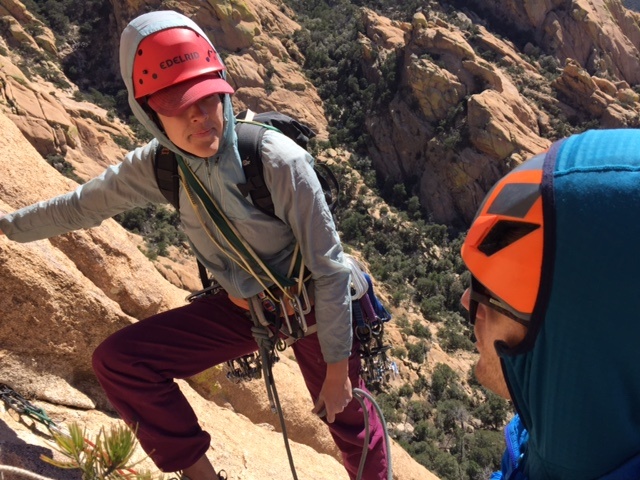 Photo by Rosemary Saal
Photo by Rosemary Saal
Sport Climbing Gear
Sport climbing usually takes place on pre-bolted routes, and climbers clip quickdraws into the bolts as they ascend. Here's how your gear selection differs for sport climbing:
- Quickdraws: In addition to needing climbing shoes, a harness, a helmet, and a belay device, the emphasis here is on having a set of quickdraws to clip into the bolts as you climb. A set of 12 to 18 quickdraws is a good place to start for most sport climbing routes.
- Rope: Sport climbers use dynamic ropes, typically in the 9mm to 10mm range, which provide a balance between durability and weight. If you are buying your first rope, we recommend buying one on the larger diameter as they are generally cheaper, more durable, and easier to handle belaying. Experienced climbers often opt for skinnier ropes as they are lighter and this can help them on challenging routes.
Traditional (Trad) Climbing Gear
Trad climbing is known for its emphasis on placing removable protection like nuts and cams in the rock as you ascend. This includes active and passive protection.
Active protection relies on a mechanical camming or spring-loaded mechanism to grip the rock and provide security. These devices have moving parts that expand or contract to create a secure placement. Common examples of active protection include camming devices (cams) and spring-loaded nuts (SLCDs).
Passive protection involves protective gear that doesn't have moving parts or mechanisms. Climbers place these pieces of gear into cracks, fissures, or pockets in the rock, relying on their static shape and friction to stay in place and withstand the force of a fall. When correctly set, passive protection can create reliable anchor points, making it an essential part of trad climbing, particularly in situations where active protection may not fit securely or is not practical to use.
The choice between active and passive protection depends on the specific characteristics of the climbing route, the rock type, and the preferences of the climber. Active protection is often favored in situations where crack sizes vary widely, while passive protection is valuable for its reliability in specific crack configurations and its simplicity. Many climbers carry a combination of both types to have a versatile range of protection options on hand.
- Climbing Nuts: Nuts are passive protection pieces that you wedge into constrictions in the rock. They come in various sizes and are lightweight, making them a staple in trad climbing.
- Cams: Cams are active protection devices that expand to fit cracks. They're versatile but heavier than nuts, so it's crucial to select the right mix based on your route.
- Hexes: Hexes and tricams are both examples of passive protection. Hexes are excellent for irregular, non-parallel cracks where traditional cams or nuts may not fit securely. Their hexagonal shape allows them to jam effectively in these types of cracks.
- Tricams: Tricams feature a camming mechanism and a design with a slender, tapered head that can be set passively like a nut or cammed actively in horizontal cracks, pockets, and other irregular features. This dual functionality makes tricams versatile for protecting horizontal cracks, pockets, and other placements where typical cams or nuts may not fit securely.
- Slings and Runners: Climbers in trad environments need to carry a selection of slings and runners to extend protection placements and reduce rope drag.
- Nut Tool: A nut tool can come in handy when you need to remove stuck protection from the rock and is often necessary to remove nuts.
Top Rock Climbing Gear Picks from NOLS
Remember, it's essential to choose gear that suits your specific climbing needs, preferences, and body type. Different terrains and climbing styles may require adjustments in your gear selection, so it's crucial to consult with experienced rock climbers before hitting the crags.
Again, we recommend always using climbing gear that is UIAA-certified. UIAA certification is the most important aspect of any weight-bearing climbing equipment.
If you decide to join us on a NOLS rock climbing expedition, remember to consult your course description and gear guide for more information about what specific gear is required for your course, as well as what required equipment is available for rent in the NOLS store and what equipment will be provided by NOLS.
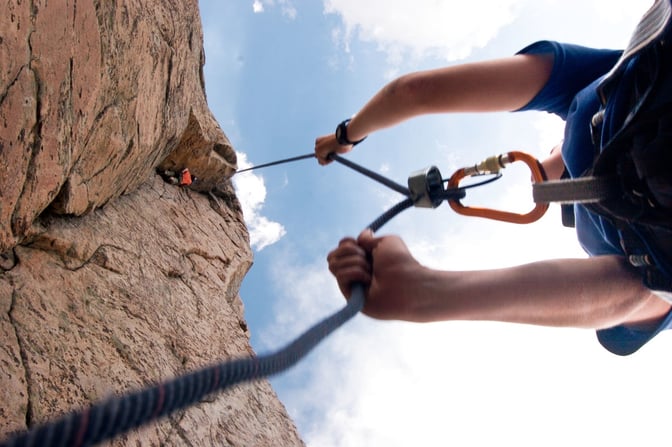 Photo by Nacho Grez
Photo by Nacho Grez
Here are our rock climbing gear recommendations for personal use:
- Harness: Petzl Sama — The Petzl Sama provides a good balance of comfort and versatility, allowing for a snug fit and easy gear access during climbs. You need a harness that feels like an extension of yourself, and the Sama delivers just that.
- Climbing Shoes: La Sportiva Mythos — We recommend buying climbing shoes that don’t force your toes to curl; they should be suitable for wearing and climbing all day and for multi-pitch climbs. Proper fitting shoes from brands like Black Diamond, Scarpa, La Sportiva and Butora are ideal.
- Belay Device: Black Diamond ATC Guide — For reliable belaying and smooth rappels, the Black Diamond ATC Guide is a great choice. Its versatile design caters to various climbing situations, from multi-pitch climbs to simple belaying. When you trust your belay device, you can focus on the climb ahead.
- Locking Carabiner: Black Diamond Pearlock Screwgate Carabiner — Whether you’re trad climbing or sport climbing, a locking carabiner is an essential component of your belay setup. This HMS carabiner from Black Diamond is designed specifically for belaying. It is easy to use and offers good control when rappelling or belaying.
- Quickdraws: Black Diamond Hotwire Quickdraws — These quickdraws provide the confidence and security you need when clipping bolts on a sport route. Their ergonomic design and snag-free features make them a top choice for climbers seeking efficiency and protection in their ascent.
- Helmet: Black Diamond Half Dome — The Black Diamond Half Dome offers top-notch protection without compromising comfort. Its hybrid design balances durability and weight, so you can climb confidently knowing your most valuable asset is secure.
- Climbing Ropes: Sterling Velocity XEROS 9.8mm — The Sterling Velocity XEROS 9.8mm is a rope that consistently meets the demands of various climbing styles and terrains. Its durability, handling, and weight balance make it a reliable choice, especially when you're counting on your rope for safety.
- Protection: Black Diamond Camalots — When it comes to trad climbing, we trust Black Diamond Camalots. Their dependability and range of sizes are invaluable for protecting different crack types. Knowing you've got solid gear in place gives you the confidence to push your limits.
- Crash Pad: Black Diamond or Metolius — When it comes to bouldering, having a reliable crash pad beneath you is non-negotiable. Black Diamond and Metolius offer affordable and UIAA-certified crash pads that will have your back when bouldering.
Caring for Your Climbing Gear: Ensuring Longevity and Safety
Climbing gear is expensive! It's crucial to know how to maintain and extend the life of your climbing equipment. Proper care not only ensures your safety but also helps you get the most out of your investments.
Check out these tips for prolonging the life of your gear, including cleaning, storage, and recognizing when it's time to retire and replace items.
Tips for Prolonging the Life of Climbing Equipment
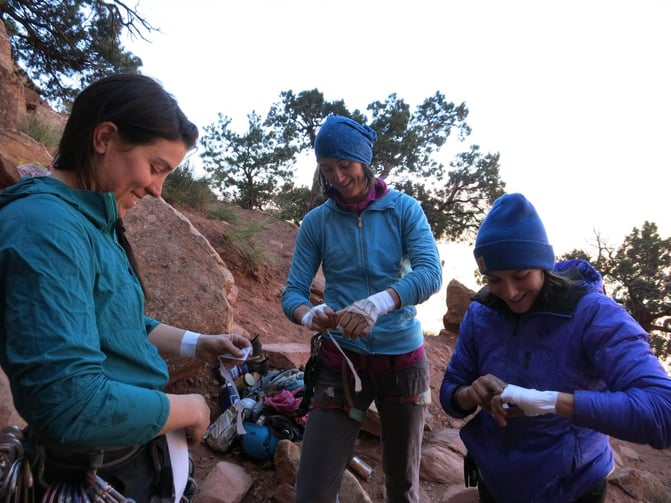 Photo by Jessica Fuller
Photo by Jessica Fuller
Regular Inspection: Prior to and after each climbing session, allocate a few minutes to meticulously assess your gear for wear, damage, or vulnerabilities.
- Pay particular attention to your harness, scrutinizing weight-bearing components like leg loops, the webbing part of the hip belt, the belay loop, and the buckle system. If you spot fraying beyond the surface level, it's time for retirement.
- Keep a keen eye on the webbing's edges, as significant fraying may compromise the stitching. Ropes, often subject to light fraying, should be retired if substantial fraying reveals the core or stitching if you detect deformities, or if they no longer maintain a smooth curve when pinched and run through your hands.
- For protection devices, such as nuts and cams, treat the webbing components akin to a harness inspection. Examine the metal elements to ensure they remain free from deformation, and confirm that cam trigger wires are not fraying. In the case of nuts or cam stems, ascertain that wire cables are not exhibiting signs of significant fraying or bending. It's essential to note that fraying on metal gear is not normal.
- As for carabiners, verify that there is no substantial wearing of the metal where the rope runs through (retire if more than 1/4 of the thickness is lost), confirm that the gate opens and closes smoothly, and check for any pronounced dings, cracks, or deformities.
Follow Manufacturer Guidelines: Always adhere to the manufacturer's guidelines for usage and maintenance. Different gear may have specific care instructions, and deviating from them could affect the gear's integrity.
Proper Handling: Treat your gear gently. Avoid stepping on ropes or leaving hardware exposed to harsh elements. Handling gear with care can significantly extend its lifespan.
Proper Storage: Store your gear in a cool, dry place, away from direct sunlight and extreme temperatures. Exposure to UV rays and heat can weaken materials over time.
Avoid Contamination: Keep your gear clean and free from contaminants like chemicals, oil, urine, or dirt. These can degrade materials and reduce their strength.
Cleaning Gear: When, Why, and How
Cleaning your gear is an essential part of maintenance. Here's when, why, and how to clean different climbing equipment:
- Ropes: Clean your rope as necessary when it becomes noticeably dirty or sandy. Use lukewarm water and a specialized rope brush to remove dirt and grime. In cases of extreme dirt, consider using a designated rope cleaner. Rinse thoroughly and allow it to air dry away from direct sunlight.
- Harnesses: Spot-clean your harness when required using warm water and a soft brush. Avoid machine washing, as it can damage the harness. Rinse thoroughly and air dry.
- Carabiners and Quickdraws: Wipe down carabiners and quickdraws with a clean, damp cloth after each use to remove dust and dirt. Lubricate moving parts with cam lube made for climbing gear, such as Metolius Cam Lube.
- Helmets: Helmets can be wiped clean with a damp cloth. Avoid using abrasive materials or harsh chemicals that can damage the shell or weaken the helmet.
- Climbing Shoes: Clean your climbing shoes by brushing off excess dirt and grime. Avoid submerging in water, as it can affect the shoe's adhesive and will likely make leather shoes shrink. Let them air out to prevent odor.
Proper Storage to Prevent Wear and Tear
Storing your gear correctly can make a significant difference in its longevity:
- Ropes: Coil your rope and store it in a rope bag or a rope tarp to protect it from dirt, extreme temperatures, and UV rays. Avoid sharp bends or kinks when coiling.
- Harnesses: Hang your harness in a cool, dry place to maintain its shape and prevent deformation. Avoid storing it in direct sunlight.
- Carabiners and Quickdraws: Keep carabiners and quickdraws organized on a gear rack or a carabiner hanger. This prevents entanglement and damage.
- Helmets: Store your helmet in a cool, dry place away from direct sunlight. Avoid stacking heavy objects on top of it, as this can weaken the shell.
Recognizing When It's Time to Retire and Replace Gear Items
No matter how well you care for your climbing gear, there comes a time when it must be retired and replaced. Here are signs to look for:
- Ropes: If you notice significant wear, cuts, or damage to the sheath, it's time to retire the rope. The same applies if the rope has taken a significant fall and has become deformed because of this or if it's reached its retirement age, typically about five years of light use.
- Harnesses: Retire a harness if you see any signs of wear or damage, such as fraying webbing or worn belay loops. Also, replace it if it has been subjected to a substantial fall – bigger than a factor 1 fall — or impact that has significantly impacted the quality of the harness.
- Carabiners and Quickdraws: If carabiners or quickdraws show signs of stress, deformation, or deep grooves, it's time to replace them. If the gate sticks in the open position or if there are any visible cracks or damage mean they should be retired immediately.
- Helmets: A helmet should be retired if it has been involved in any impact, even if there are no visible cracks. Helmets are designed to absorb the force of a single impact, so they may not provide adequate protection after a fall or blow.
- Climbing Shoes: Climbing shoes should be replaced when the rubber is worn through or the shoe's structure is compromised. If the rubber is worn down to the rand, it is a good idea to stop climbing on and consider getting it resoled, as damaging the rand makes this process harder and more costly. Loss of sensitivity, fit, or performance is a sign that it's time for new shoes.
Regular maintenance and care, combined with recognizing the signs of wear and tear, are essential for ensuring the longevity and safety of your climbing gear.
By following these guidelines, you'll be able to enjoy many successful climbing adventures while keeping yourself safe.
Looking for Your Next Climbing Adventure?
Nothing beats hands-on learning from seasoned climbers and experienced instructors when it comes to gaining the knowledge and skills needed to make informed gear choices for your climbing adventure.
Whether you're just starting out or have some climbing experience under your belt, you’ll thrive in the immersive environment of a NOLS rock climbing course.
Build your climbing skills, develop risk management skills, embrace opportunities to grow as a leader and as part of a tight-knit climbing community, and gain insights into eco-friendly practices like proper waste disposal and "Leave No Trace" ethos.
If you're ready to take your climbing game to new heights and become a part of a vibrant community, this is your chance. Check out our rock climbing courses to get started!
Written By
NOLS
NOLS is a nonprofit global wilderness school that seeks to help you step forward boldly as a leader.



